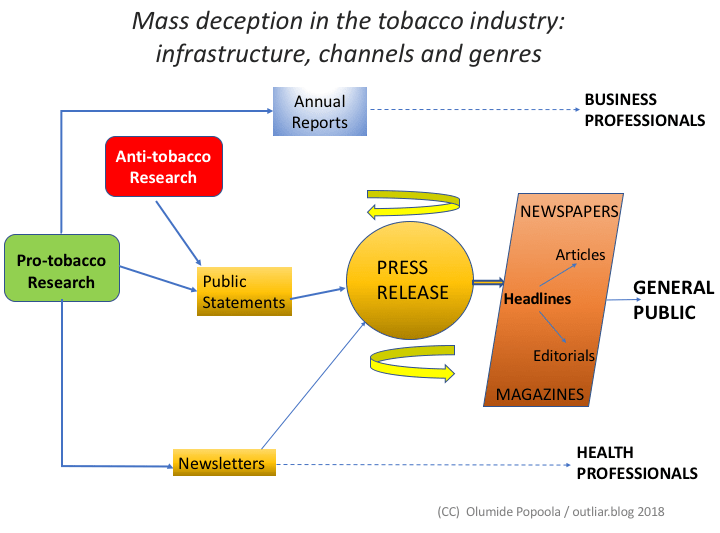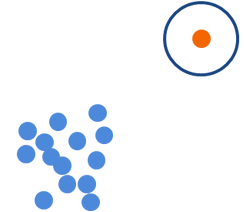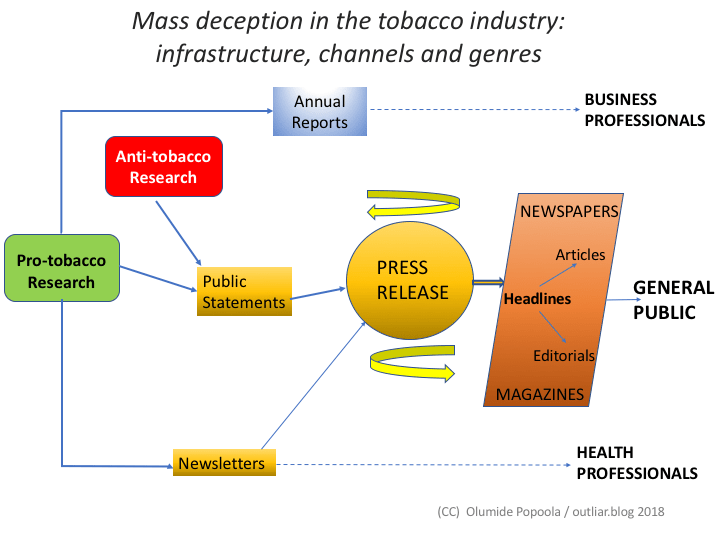In 2006, a federal court judged four of the ‘Big Five’ US tobacco companies – Phillip Morris, RJ Reynolds, British American Tobacco, Lorillard (sold to RJ Reynolds in 2014) – to have been operating for more than half a century as a de facto criminal enterprise guilty of racketeering. In November 2017, US tobacco companies finally issued, through national TV and print media, a series of statements correcting their sixty year deception of the American public. They had been appealing the original judgement for over ten years.
The ‘racket’ was the continued sale and marketing of tobacco products in full knowledge of their addictive properties and their causal connection to lung cancer. Under the Racketeer Influenced and Corrupt Organisations (RICO) Act 1970, these tobacco companies were held to have defrauded smokers i.e. obtained smokers’ money by dishonest means, specifically “deceiving smokers, potential smokers, and the American public about the hazards of smoking and second hand smoke, and the addictiveness of nicotine” (United States vs. Phillip Morris et al, 2006, p4).
Below is a list of deceptions maintained by the ‘Big Tobacco’ enterprise:
- false denial of the adverse health consequences of smoking
- publicly denial that nicotine is addictive
- concealment of research data and other evidence that nicotine is addictive
- false denial of the manipulation of nicotine levels to create and sustain addiction
- deceptive marketing and public statements suggesting ‘low tar’ cigarettes are less harmful than full-flavor cigarettes
- false denial that their marketing targets youth
- false and misleading public statements denying that environmental tobacco smoke (passive smoking) is hazardous to nonsmokers
How does one deceive the public for so long (linguistically)? My approach to this question is to first identify the agents and channels of deceptive communication. We know who received the deceptive messages but who were the senders? Did they use agents/messengers? What channels did they use?
The ‘Big Tobacco’ enterprise built an infrastructure of deception by establishing a number of front organizations i.e. groups that appear to independently support or be motivated by one particular purpose but are actually a ‘front’ for another group whose covert agenda they secretly serve. Front organizations are agent-messengers that appear to be senders. Examples of the forms that front organizations might take include think tanks, associations of consumers or workers, and single-issue interest groups.
Chief among these was the Tobacco and Industry Research Council (TIRC), founded in 1954, which later changed its name to the Centre for Tobacco Research (CTR). TIRC/CTR was established on the strategic recommendation of Hill & Knowlton, public relations counsel to the Big Tobacco enterprise. Backed by money from the Big Tobacco enterprise, it ran a multi-million dollar research programme providing substantial grants for ‘independent’ scientific research into the health effects of smoking. This produced a body of research that obfuscated the link between smoking and cancer and left their causal connection as an “open question”. TIRC/CTR also funded research that diverted discourse away from the dangers of smoking by suggesting alternative causes of cancer such as air pollution, diet and genetics.
This programme of decoy research clearly had a deceptive purpose. However, the research itself was not necessarily deceptive – it created doubt rather than false belief by challenging the anti-smoking research attracting the attention of the American government and health organisations at that time. Neither was this research directly responsible for the mass deception of the American public since the public was not the audience for scientific research.
In the 2006 judgement, Judge Kessler noted that The Big Tobacco front organisations disseminated ‘commentaries’ on both pro- and anti-smoking research through a variety of publication channels, including:
- management commentaries in annual reports, read by business professionals
- newsletters and booklets targeting medical professionals with favourable research summaries.
- public statements, comments made by tobacco-friendly scientists discrediting research that linked smoking with cancer.
Whilst annual reports and newsletters helped communicate the tobacco deception to professional outgroups, as shown in Figure 1 below, press releases were the most influential channel for reaching the general public. Every publication and statement made by a scientist connected to the enterprise was accompanied by a press release. This would be sent out to thousands of editors and then transmitted to the general public through newspapers and popular magazines.
Thus, the press release plays a doubly deceptive role; it reports the deceptive framing of the discourse around tobacco/cancer research and then amplifies its interpretation though popular media. Indeed, PR agency Hill & Knowlton prided themselves on their ability to spin “obscure scientific reports favourable to the industry into headline news across the country”.

Figure 1: Mass deception; infrastructure, channels and genres
Below (Figure 2) is one example of press release distortion of research in the tobacco domain. This 1955 study from the British Empire Cancer Campaign (a forerunner of Cancer Research), published in the British Medical Journal, reports a nuanced set of findings in relation to the carcinogenic properties of smoking. It reports findings indicating that: i) tar is not carcinogenic in mice, ii) condensation from tobacco smoke is carcinogenic in mice and iii) carcinogenic effects vary between species so more research is needed.
This nuance is lost in the press release, which seizes on the first finding related to tar and extends it to smoking and tobacco in general. The press release, authored by Hill & Knowlton, draws it authority by reporting the statement made by the TIRC chairman Timothy Hartnett and uses repetition to reinforce its point three times in the first page – “Outstanding British scientists could not induce cancer in experimental animals with tobacco smoke derivatives” / “Experiments conducted at several leading British medical research institutions had failed to induce any cancers” / “18 month experiments fail to show any connection between cancer and smoking”.
Figure 2: Comparison of British Medical Journal article and TIRC press release
The fact that this repetitive message itself references a message that is practically self-authored (considering the close relationship between TIRC and Hill & Knowlton, who even shared the same office at one stage) is indicative of the low information quotient in this press release. Yet providing information is arguably the main purpose of the press release genre. What we have here, then, is a deficient or deviant genre communication – inauthenticity (deception) has compromised the integrity of the genre.
The same has been suggested about the annual reports produced by the TIRC, “which read much like industry position papers” (USA vs Phillip Morris et al, 2006, p58). The extract below, from the 1958 TIRC annual report, is illustrative:
A problem may well be obscured, and its solution delayed, by the soothing acceptance of an oversimplified and immature [tobacco theory] hypothesis. The proponents of the tobacco theory have generated increasingly intensive and extensive propaganda. As a result, a non-scientific atmosphere, conducive to prematurity, unbalance, and inadequacy of public judgement, has pervaded the whole field. The prohibition concept discounts or ignores all considerations of smoking benefits in terms of pleasure, relaxation, relief of tension or other functions.
Once again, in this case by allowing bias to enter annual reporting, a genre is compromised through performing a deceptive purpose. These two examples suggest that the tobacco deception was partly sustained by ‘genre fronts’ – communications that appear to serve one conventional purpose but in fact fulfill functions of another genre or are simply deficient.
Press releases are more central to mass deception than annual reports because they are more frequent and produced for immediate impact in popular media. Press release spin is picked up by editors and transferred to newspapers and magazines – sometimes wholesale, sometimes with additional fervour. This resulted in a news environment that actively facilitated the disinformation strategies of the Big Tobacco enterprise leading to a massively misinformed general public.
The selection of headlines, news articles and editorials in Figure 3 below reflect the general tenor of the ‘decoy discourse’ maintained by the tobacco industry, which involved: attacking the integrity of government scientists, casting doubt on environmental controversies such as the use of pesticides and climate change, and linking cancer to spurious causes. The confluence of tobacco advocates and climate change skeptics is a striking feature of this mass deception.
Figure 3: Selection of newspaper and magazine items used to support tobacco advocacy. Taken from ‘Bad Science: A Resource Book’
Newspaper items come in a variety of sub-genres, for example news articles whose purpose is to present factual information and editorials that present an opinion. Editorials themselves can be written by newspaper staff or invited writers as ‘op-eds’. Both of these sub-genres can be used for deceptive means i.e. the presentation of false facts in news articles and the advancement of an undisclosed agenda in the case of editorials. In such cases, the news genre loses its features of objectivity and transparency and becomes distorted as ‘fake news’.
Taking the ‘tobacco deception’ as a case study, it would seem that the infrastructure for maintaining this deception was built on the deviant use of a variety of genres – annual reports, press releases, newspaper/magazine items – that were connected by channels invisible to the general public i.e. front organizations and funded scientists. The schema presented above will be used in future posts to evaluate similar deception controversies in the environmental and health domains.













